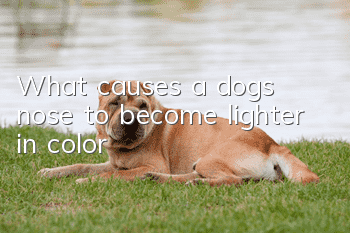What causes a dog’s nose to become lighter in color?

The lighter color of a dog's nose is usually caused by genetic problems, reduced melanin deposition, nose injuries, allergies, lack of vitamins or certain trace elements, vitiligo, infection with internal parasites, etc. If you want to improve this problem, you can usually feed your dog some foods containing tyrosine to promote the formation of melanin, such as meat, animal liver, egg yolk, goat milk powder, peanuts, black sesame seeds and walnuts. But because dogs absorb these things slowly, the experience will take longer.
1. Genetic issues
Many dogs still have black noses when they are born, but during the breeding process, the color of the nose will gradually become lighter and turn pink. In fact, this is mainly related to the dog's genes. This situation also mostly occurs in dog breeds with lighter coats, such as snow mastiffs, apricot huskies and dogs in some cold zone areas. Also, if the dog is not a purebred, then the dog will be born as a Chuanchuan dog, and the genes of Chuanchuan dogs are changeable and difficult to change.
2. Reduce melanin precipitation
The color of a dog's nose is determined by the amount of melanin. As the dog gets older, the melanin deposits will decrease, so the nose will become lighter. This situation is a normal physiological phenomenon during the growth of dogs, so don’t worry too much.
3. Nose injury
After a dog's nose is injured, the color of the wound will become lighter, but when the wound heals, the nose will return to its original appearance. It is recommended that owners keep an eye on their dogs when walking their dogs, and do not let their dogs argue or fight with other dogs. They should also not hit their dogs’ noses. This can reduce the problem of the dog’s nose becoming lighter in color.
4. Temperature changes
If the surrounding environment temperature is too low, the blood circulation in the dog's body will be reduced, which will also cause the color of the nose to become lighter. When the temperature rises, the color of the dog's nose will return to its original black color. As long as the dog's mental state and appetite are fine, there is no need to worry too much.
5. Caused by allergies
When a dog's nose comes into contact with an allergen, it can cause allergic dermatitis, causing the nose to become lighter in color. For example, some dogs may even have swollen lips from dog pots, toys or other plastic items that they come into contact with daily. Therefore, it is recommended that owners should not use plastic on their dogs.For rice bowls, it is best to use ceramic or glass rice bowls, so these problems will not occur.
6. Lack of vitamins or certain trace elements
If a dog lacks vitamins or certain trace elements, it can easily lead to nose discoloration, usually from dark to light. If this is the case, it is necessary to supplement the dog with sufficient vitamins and trace elements in a timely manner to provide balanced nutrition. It is not recommended to use human vitamin products for dogs.
7.Vitiligo
Leukoplakia in dogs can also cause the nose to discolor and the hair to have patches of white spots. This condition can generally be alleviated by improving your diet.
8. Infection with internal parasites
When a dog is infected with internal parasites, it will cause damage to the base layer of the skin and affect the normal metabolism of melanin. If it is caused by this reason, the dog usually has a history of skin damage, so the dog must be dewormed regularly.
- Dog tongue turns purple
- How to treat arthritis in golden retrievers
- Why don’t dogs like to drink water?
- What should I do if my puppy is picky?
- What to do if your dog catches a cold? You need to know this!
- What should I do if my dog sheds a lot of hair in winter?
- How to feed Pekingese puppies
- How to train Border Collie, several common training methods for Border Collie!
- How to train an English Springer Spaniel? Give them more rewards and support!
- Shiba Inu personality and appearance characteristics



